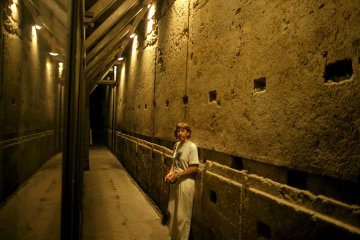Tunnel Trouble

| |
| The moving model of the Temple area. Robinson's and wilson's Arches slid away at the touch of a button. |
Back in 1994 our tour group was privileged to work at the Western Wall excavations, to the south of the holiest site in Judaism. We were also aware, as we worked, that we were just to the west of one of the three holiest sites in the Muslim world, the Dome of the Rock mosque. This juxtaposition has caused a number of problems down through the years and trouble erupted two years later.
One morning during the dig we were privileged to visit the excavations beside the Western Wall, to the north of the holy site. We were first treated to a marvellous sound and light show centred on a detailed model of the Tyropoean Valley. As the guide described the finds to us he pressed on a remote control and spotlights came on or switched off, parts of the model rose or fell, slid sideways into position or swivelled back again, all to show how the site looked in the time of Christ and how it reached its present appearance.
After this we were taken for a stroll through the long, narrow tunnel that forms the excavation. Two things impressed me about this. The first was the size of some of the stones that made up the temple wall. One, which was pointed out to us, was twelve feet high, ten feet wide and forty-eight feet long! The second thing was our guide's remark that all the excavating was done by yeshiva students, because of the holiness of the site. Trained archaeologists supervised every spoonful of earth they removed, but the experts were not allowed to touch the sacred soil.

| |
| "Petra" stands beneath the massive stone 12'x10'x48' referred to in the article. |
At the time we were there, tours of the excavations could only be organised in advance and were limited to small numbers at a time. The reason for this was that when the tour was over, we had to retrace our steps along the narrow tunnel and go out the same way we came in. In 1996 the Israeli Tourist Authority opened the site to more free access by breaking through the end of the tunnel to the surface somewhere near the Via Dolorosa — and thereby provoked a violent reaction from the Muslims.
Tunnels under Jerusalem have always been a touchy point with the sometimes paranoid Arabs. For all the years of Jordanian possession, between 1948 and 1967, King Solomon's Quarries near the Damascus Gate were walled off and no one was allowed into them — for fear that the Jews would creep in under Jerusalem and blow up the Dome of the Rock. This closure was bitterly resented by Freemasons, who were in the habit of conducting secret ceremonies in the famous quarries.
The exact nature of the Arab grievance this time is not entirely clear. The mere opening of the tunnel seems too trivial an event to justify the wide-scale rioting, to say nothing of the large number of dead and wounded. It is more likely that this has been the proverbial straw that broke the camel's back, the last offence against people already frustrated over the almost moribund Peace Process. We can only hope that common sense, that most uncommon of attributes, prevails — on both sides — and that peace will soon return to the Holy Land but given past history of Arab touchiness and Jewish sabotage, we are not holding our breath.





